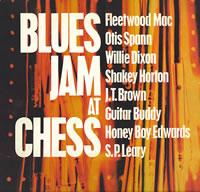Not Your Stevie Nicks Fleetwood Mac!
There were good reasons British blues musicians like the original Peter Green led Fleetwood Mac or blues influenced ones like The Rolling Stones wanted to record in Chess\\'s legendary Ter-Mar Studios in Chicago. One, of course, was the possibility of jamming with blues legends like Willie Dixon, Otis Spann, Muddy Waters, Howlin\\' Wolk and, well, you can run down the names yourself, including “Guitar Buddy,” what Buddy Guy had to be called due to contractual obligations.There were good reasons British blues musicians like the original Peter Green led Fleetwood Mac or blues influenced ones like The Rolling Stones wanted to record in Chess's legendary Ter-Mar Studios in Chicago. One, of course, was the possibility of jamming with blues legends like Willie Dixon, Otis Spann, Muddy Waters, Howlin' Wolk and, well, you can run down the names yourself, including “Guitar Buddy,” what Buddy Guy had to be called due to contractual obligations. The other reason is to get that fabulous Ter-Mar Sound, which The Stones managed to do on some of their earlier albums.
This set featuring the original Mac jamming amongst themselves and with a host of blues greats including all of the above save for Wolf and Waters, plus Shakey Horton, “Honey Boy” Edwards and a few others, under the direction of Willie Dixon. All of it was recorded in one day, January 4th, 1969, when unfortunately, much of the Chess roster was unavailable.
Fleetwood Mac aficionados consider this Mac to be the only real Mac-the one with Green, Jeremy Spencer, John McVie, Mick Fleetwood and later Danny Kirwan, but when these sides were originally issued, fans stayed away, which is a real shame as hopefully you'll find out when you get this.
If you don't dig the blues, you might not have a good time here, and if you like Abba influenced pop, you probably like the Buckingham-Nicks Mac better. Me? I like them both, for different reasons. But to hear Peter Green near his prime is reason enough to give a listen.
Whatever you think of the blues, you gotta love the sound of these recordings, and more importantly the spirited playing as the veterans join in the fun of playing with the white youngsters from across the sea.
These are jams- surprisingly tight ones-with snippets of producer Mike Vernon's communication between the recording booth and the studio left in between the music to help give you an indication of how the tunes were conceived. Much was left on the cutting floor for the original double LP, with most of it being restored for 1999's Fleetwood Mac: The Complete Blue Horizon Sessions 1967-1969 CD box set.
Side two here, featuring Jeremy Spencer, is my favorite. His stinging slide guitar has been recorded with a distant, reverberant “lonesome highway” sound that's killer. He's backed by J.T. Brown on tenor sax playing long, simple, mournful lines that just cut through the bullshit. Brown had played with Spencer's hero Elmore James, and his excitement playing with Brown jumps from the grooves.
Probably recorded to a 4-track recorder, the tracks are assigned in a hard-panned fashion, with Mick Fleetwood's drums hard-right, guitars hard left, soloist and lead singers dead center. Whatever deficiency that set up has in terms of creating a natural picture are more than made up for by the sheer balls of the recording itself. As with most of what came out of Ter-Mar, these sessions are dynamic, direct, full bodied, full range, and totally honest-sounding. The mastering from the original analog tapes is stupendous as is the pressing quality.
For Mac fans used to hearing this material on the CD box set, these LP sides will be a revelation. The box sound is dry, literal and flat. The LP is three dimensional, harmonically rich and wet. One lives and breaths music, one transmits datal, though I'm sure the mastering guys did the best they could.
This set represents the last pure blues recordings made by the original Fleetwood Mac. A week later, The Biggest Thing Since Colossus (Blue Horizon 7- 63217) also available from Pure Pleasure, was recorded in New York with Otis Spann, but Spencer and Fleetwood were not present.




